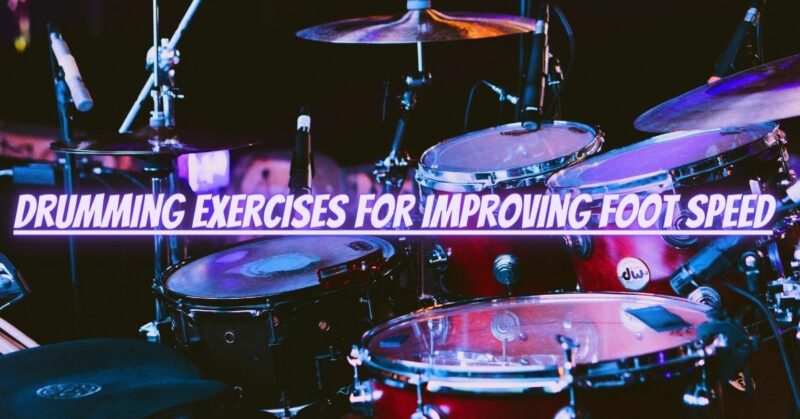Foot speed and control are essential for drummers looking to deliver powerful and intricate rhythms. Whether you’re playing fast-paced rock beats or intricate double bass patterns in metal, developing foot speed will significantly enhance your drumming skills. In this article, we will explore a series of drumming exercises specifically designed to improve foot speed, agility, and control. By incorporating these exercises into your practice routine, you can take your drumming to the next level and achieve impressive footwork capabilities.
- Heel-Toe Technique: The heel-toe technique is a widely used method to increase foot speed and play faster single strokes on the bass drum. Start by placing your foot flat on the pedal with your heel down. Strike the bass drum by lifting your leg from the knee and using the ball of your foot to strike the pedal. As the beater rebounds, quickly drop your heel down to strike the pedal again. This combination of heel-up and heel-down movements creates a continuous flow of strokes, increasing speed and efficiency.
- Single Pedal Speed Exercise: This exercise focuses on developing foot speed and control with a single bass drum pedal. Set the metronome to a comfortable tempo and play a steady stream of eighth notes on the bass drum. Gradually increase the tempo while maintaining consistent and controlled strokes. Pay attention to accuracy, volume control, and evenness between each stroke. This exercise builds endurance and helps train your foot muscles to move swiftly and accurately.
- Double Bass Drum Technique: For drummers utilizing a double bass drum setup, working on double bass drum technique is essential for achieving speed and coordination. Begin by practicing double strokes with each foot separately, ensuring that both feet produce consistent and even sounds. Gradually increase the speed while maintaining control. Once comfortable, practice patterns that alternate between the two bass drums, such as single strokes, double strokes, and various combinations. Focus on synchronization and accuracy between both feet.
- Foot Control Exercises: Developing foot control is crucial for executing complex patterns and maintaining consistent volume. Practice exercises that emphasize different foot techniques, such as heel-down strokes, heel-up strokes, and toe-toe strokes. Start at a slow tempo and gradually increase the speed while maintaining control and precision. Incorporate variations in dynamics, such as playing accents and ghost notes, to further enhance foot control and articulation.
- Bass Drum Independence: Foot independence exercises improve your ability to play different rhythms with your bass drum while maintaining a steady beat with your hands. Practice patterns that involve playing different subdivisions or syncopated rhythms with your feet, such as quarter notes with the bass drum and eighth notes with your hands. Focus on keeping both the bass drum and hand patterns consistent and synchronized. This exercise enhances coordination and fosters greater control over your footwork.
- Double Bass Drum Pedal Techniques: If you use a double bass drum pedal, explore various techniques such as heel-toe, slide, swivel, or heel-up techniques. Each technique offers a unique approach to achieving speed and control. Experiment with different techniques and find the one that suits your style and preferences. Practice exercises specific to each technique, gradually increasing the tempo while maintaining accuracy and control.
- Rhythmic Variation Exercises: To further enhance foot speed and coordination, incorporate rhythmic variation exercises into your practice routine. Play patterns that involve different note subdivisions, such as sixteenth notes, triplets, or quintuplets. Start at a slow tempo and gradually increase the speed while maintaining rhythmic precision. Focus on developing a smooth and controlled flow of notes with your footwork.
- Incorporate Bass Drum Rudiments: Similar to hand drumming, bass drum rudiments exist to improve technique and control. Explore bass drum rudiments such as the single stroke roll, double stroke roll, paradiddle, and flam exercises. Practice these rudiments with your foot, gradually increasing the speed and complexity. This exercise improves foot dexterity, speed, and control, enabling you to execute intricate patterns and fills.
- Practice with a Metronome: Utilize a metronome throughout your foot speed exercises to maintain consistent timing and precision. Start at a comfortable tempo and gradually increase the speed as your skills progress. The metronome acts as a guide, helping you develop a solid sense of timing and ensuring that your footwork stays in sync with the beat.
Conclusion: Improving foot speed and control is a continuous process that requires focused practice and dedication. By incorporating exercises such as the heel-toe technique, single pedal speed exercises, double bass drum technique, foot control exercises, bass drum independence exercises, double bass drum pedal techniques, rhythmic variation exercises, incorporating bass drum rudiments, and practicing with a metronome, you can enhance your footwork capabilities and take your drumming to new heights. Remember to start slow, maintain focus on technique and accuracy, gradually increase the speed, and practice consistently. With dedicated effort and a commitment to developing your foot speed, you’ll be able to execute impressive and intricate footwork with confidence and precision.


